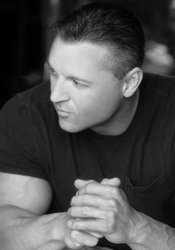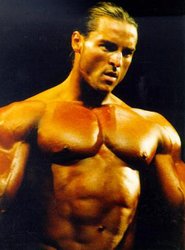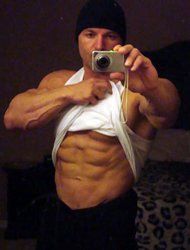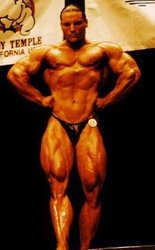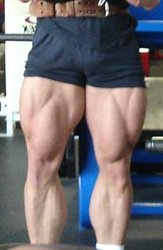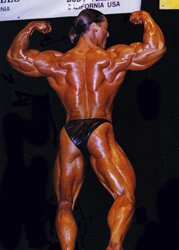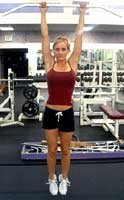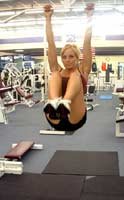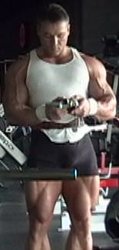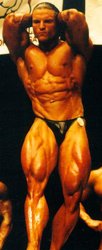HIT: Is It the Best Way to Train?
As popularized by no less than six-time Mr. Olympia Dorian Yates and bodybuilding legend Mike Mentzer, HIT (High Intensity Training)—formerly a controversial method of training requiring ultra-short duration workout sessions—has become a muscle building system in its own right that is now impossible to ignore.
Despite the undeniable fact that HIT, both from a theoretical perspective and as it is practically applied, is both logical in its methodology and works wonders for muscle growth while cutting workout time by up to 60 percent, many people look upon it with scepticism entrenched through many years' conventional style training requiring upwards of five sets per exercise and four to five exercises per body part.
Since HIT is a proven system of training that is easy to implement and time-saving, why might it then be difficult for people to break from the conventional training mindset that preaches volume and massive amounts of backbreaking work over the HIT mentality of short, sharp sessions encompassing a handful of high intensity sets? There are several factors not the least being misinformation and training attitude.
Since the bodybuilders we see in the popular magazines proudly portray massive muscles while grinding out multiple sets of a staggering array of different exercises (as explained in the training programs that accompany the articles), the logical conclusion most draw is that to gain the kind of size and shape demonstrated in the glossies one must similarly train under a volume methodology. These people don't factor in drugs and genetics.
The champions, you see, possess enviable genetic predispositions for gaining extreme size while taking all manner of bodybuilding performance enhancing drugs to fully exploit said genetic ability.
For most of us, training with average genetics while remaining drug-free might cause the application of the comparatively excessive training sessions featured in the magazines to constitute muscle-building overkill. Better to train less often and more intensely one would think.
Bodybuilders—both recreational and competitive—also tend to possess a mindset geared towards volume. After all, to achieve anything worthwhile in life we are to work long hours and apply ourselves for the long haul, right?
True to an extent in our day-to-day lives, but not so, as you will soon read, when it comes to building muscle. When aiming for quality mass 'less is best' is a mantra well worth following and HIT is its underpinning blueprint for success.
HIT, in its purest form, has as its governing precept the application of optimal intensity over one all-out set of an exercise, one or two exercises per session. Several warm-up sets might be included. That is all. A variant on this bare bones form of HIT includes two all-out sets per exercise, three exercises per session, with one warm-up set before each movement.
Whatever form of HIT is followed, each work set must be done to complete muscular failure, the HIT rationale being that upon sufficiently exhausting a muscle, further sets would:
- Be counterproductive to full muscular recovery
- Be impossible to generate optimal intensity throughout
- Prove a waste of time
One man who has used HIT to build his own impressive physique is former amateur bodybuilding champion Gordon LaVelle. So impressed was he with the results he experienced that he wrote a book on this underused and often derided form of training. Now considered an expert on HIT, Gordon educates people as to its merits. I spoke with him recently and he shared his HIT thoughts with me.
Included with this article are HIT programs Gordon currently and formerly has personally used to build extreme mass.
Interview

[ Q ] Hello Gordon. Could you please provide some background on yourself?
- I was competitive bodybuilder in the mid-1990s. I never became a professional, though I did very well at the amateur level, and was able to beat a handful of guys that later became pros. Nevertheless, I've been training as a bodybuilder for the past 25 years. By that I mean - like all bodybuilders - I go to a gym and lift weights.
The similarities between my training and that of most other bodybuilders end there. I employ an unusual strategy of training, one that has allowed me to build and maintain a large amount of muscle over a very long period - with a minimal investment of time and without injury.
- Since most bodybuilding workouts are lengthy and eventually dangerous, I believe that what I do in the gym is far superior - so much so that I felt compelled to write the book
- to describe it.

[ Q ] In a nutshell, what is your training philosophy? 
- With weight training, like anything else in life, you should follow a simple rule: Whatever you do, have good reasons for doing it. That's a very general rule, which is appropriate, since life is a very general experience. The major points are decided for us: We're born, we live for a while, and then we die. In between we work on the specifics, and that part is up to us.
Specific human actions are mainly not independent in intent; rather, they're the means we use to fulfil a greater purpose, to achieve a goal.
Weight training is a good example of this. People lift weights because they want to be bigger, or stronger, or enhance their appearance, or any combination of these things. These things are all goals.
Training for Mass concerns itself with the goal of building muscle. If you happen to have this goal, you should approach it like any other. You should concern yourself with the process. Identify a strategy and put it into effect. And with every step you take to achieve that result, you should have good reason.
- Most people that train with weights think they have good reasons for what they do in the gym, mainly because they don't think that hard about it. I used to be one of these people, and I committed their biggest error: I never bothered to discern correlation from causal relationship.
I would copy the routines of top bodybuilders from magazines, assuming that anything and everything they did in the gym was the cause of their muscular growth.
It wasn't until I became aware of the high-intensity theory of weight training that I realized that the training routines of these people correlate to their results - but that only part of what they were doing could be classified as a cause. It's easy to fall into this trap. If you see someone that has built a great deal of muscle, it's logical to assume that this person's workout is optimally effective and efficient.
- The fact is that most bodybuilding workouts are inefficient and wasteful. A typical bodybuilding workout will produce the growth of muscle, but it will also contain a fair amount of work that does not have this effect. As if that weren't inefficient and wasteful enough, often times a good amount of time and energy is devoted to training that has the opposite effect.
The result is that the typical bodybuilding workout and the growth it stimulates viewed, as a whole, constitutes a correlation and not a causal relationship.
Growth is caused by intense workouts, not lengthy ones. As long as the intensity is sufficient, an effective workout-one that stimulates the growth of muscle-can be very, very brief.
- Research and real-life application has shown that the only important exercise factor in the stimulation of muscular growth is intensity. My training philosophy is that this knowledge should be the foundation of what takes place in the gym.

[ Q ] What are the biggest advantages to using the HIT method?
- Like I mentioned above, we're born, we live for a while, and then we die. When you draw your last breath, hopefully you'll be able to look back and be happy about what took place in your tiny corner of the Universe.
Let's assume that building muscle is important to you. At its best, high-intensity training can improve your overall life experience. It can allow you to achieve the same or often better results in much less time than the typical bodybuilding regiment. Less time in the gym means more time doing other things, more time pursuing happiness.
Yet in what would seem to be a paradox, the idea of pursuing happiness is where high-intensity training fails to appeal to many.
- I've found that the most resistance to the high-intensity approach comes from people that actually want to spend long hours in the gym every day. That's where their happiness comes from, so they will scoff at HIT and never attempt to understand the logic behind it. They therefore really don't know what it is; they just know that they're against it.
It is true that the very brief nature of high intensity training can make it seem like a farce to anyone who is not taught the logic supporting it. But once you become acquainted with the simple reasoning and make an earnest effort to put it into effect, your mind will almost certainly change.
But again, since the brief nature of the method is inconsistent with desire to conduct long training sessions, many people are determined to guard themselves against the knowledge.
So they happily continue to train for long hours. They're unaware that they necessarily run a much higher risk of overtraining, and many are only vaguely aware that overtraining is even a bad thing. And most importantly, these people run the risk of injury.
- When bodybuilders show casual interest in Training for Mass, I encourage them to read - if nothing else - the chapter on injury. The fact is that HIT is safer than the traditional approach, for the simple reason that your connective tissue can only take so much hard work.
HIT by definition places a great restriction on the volume of work you perform, while traditional approaches and unbridled enthusiasm encourage the opposite. A significant injury can cause your training to stall for several months, and in the worst of cases it can force you to quit bodybuilding entirely.
If you want to lift weights for many years, and you're also performing the typical 12-20 working sets per body part, you're tempting fate. After reaching a certain age, the human body begins to slowly disintegrate. Volume weightlifting can accelerate the disintegration of certain parts of the body, namely its connective tissue.
There is another point that's very interesting: Although high-intensity training is frequently derided, it is a style of training that just about everyone uses. Everyone performs a single high-intensity set for each exercise. Many just make the mistake of performing more sets, and often times lots of sets.
The crux of the HIT method is applying the realization that training beyond the point of growth stimulation, which can be achieved with a single set, negates its advantages.
- The following is a sample HIT training plan. Like most high-intensity programs, a few or even several warm-up sets are performed before the final, working set.
The warm-up sets should be stopped well short of failure. The warm-up sets have zero value for stimulating muscular growth, but they're essential for avoiding injury when the heavy, final set takes place.
The working set should be taken to or beyond failure. The number of reps used in the working set should be in the range of 8-12. However, sometimes higher reps, especially in the case of lower-body training, can be very effective (and these can range to 20 reps and beyond).
Day 1: Quads and Glutes
- Squats: 1 set
- Leg Press: 1 set
- Leg Extensions: 1 set
- Adductors: 1 set
- Glute Kick-backs: 1 set
 Click Here For A Printable Log Of Day One: Quads & Glutes.
Click Here For A Printable Log Of Day One: Quads & Glutes.
Day 2: Chest, Triceps and Abs
- Barbell Incline Press: 1 set
- Decline Bench Presses: 1 set
- Close-Grip Bench Press: 1 set
- Hanging Leg Raises: 2 sets
 Click Here For A Printable Log Of Day Two: Chest, Triceps & Abs.
Click Here For A Printable Log Of Day Two: Chest, Triceps & Abs.
Day 3: Rest
Day 4: Back and Biceps
- Lat Pull-down: 1 set
- Barbell Rows: 1 set
- Close-Grip Lat Pull-down: 1 set
- Alternating Dumbbell Curls: 1 set
- Machine Preacher Curls: 1 set
 Click Here For A Printable Log Of Day Four: Back & Biceps.
Click Here For A Printable Log Of Day Four: Back & Biceps.
Day 5: Shoulders and Hamstrings
- Machine Shoulder Presses: 1 set
- Side Laterals: 1 set
- Rear Delt Flyes: 1 set
- Dumbbell Shrugs: 1 set
- Lying Leg Curls: 1 set
- Seated Leg Curls: 1 set
 Click Here For A Printable Log Of Day Five: Shoulders & Hamstrings.
Click Here For A Printable Log Of Day Five: Shoulders & Hamstrings.
Day 6 and 7: Rest
This should not necessarily be viewed as an optimal combination of exercises for everyone. Some may favor flat benching over decline presses, for example. That's perfectly fine, and it should be expected that everyone will find his favorite exercises for each body part. However, the primary elements of a good HIT routine are found above: Emphasis on compound movements, sufficient rest periods, and a single, high-intensity set for each exercise.
Another thing worth noting is the absence of any exhaustive abdominal routine. Taking a couple of sets of hanging leg raises to failure is all you need in an effective ab workout.
- The following is my current training regiment. For each exercise, a number of warm-up sets are performed, followed by a single high-intensity set (taken to or beyond failure).
Day 1: Quads
- Leg Press (Narrow Stance, High Foot Position): 1 set
- Leg Press (Wide Stance, Low Foot Position): 1 set
- Flutter Kicks: 1 set
- Leg Extensions: 1 set
 Click Here For A Printable Log Of Day One: Quads.
Click Here For A Printable Log Of Day One: Quads.
Day 2: Chest and Triceps
- Smith Machine Incline Bench Press: 1 set
- Decline Bench Press: 1 set
- Triceps Push-downs: 1 set followed immediately by
- Close-Grip Bench Press: 1 set
 Click Here For A Printable Log Of Day Two: Chest & Triceps.
Click Here For A Printable Log Of Day Two: Chest & Triceps.
Day 3: Rest
Day 4: Back and Abs
- Lat Pull-downs: 1 set
- Bent-Over Barbell Rows: 1 set
- Close-Grip Pull-downs: 1 set
- Hanging Leg Raises: 2 sets
 Click Here For A Printable Log Of Day Four: Back & Abs.
Click Here For A Printable Log Of Day Four: Back & Abs.
Day 5: Hamstrings, Glutes and Inner Thighs
- Lying Leg Curls: 1 set
- Seated Leg Curls: 1 set
- Abductors: 1 set
- Flutter Kicks: 1 set
- Adductors: 1 set
 Click Here For A Printable Log Of Day Five: Hamstrings, Glutes & Inner Thighs.
Click Here For A Printable Log Of Day Five: Hamstrings, Glutes & Inner Thighs.
Day 6: Rest
Day 7: Shoulders
- Machine Shoulder Press: 1 set
- Lateral Raises: 1 set
- Rear Delt Flyes: 1 set
- Dumbbell Shrugs: 1 set
 Click Here For A Printable Log Of Day Seven: Shoulders.
Click Here For A Printable Log Of Day Seven: Shoulders.
Day Eight: Biceps, Abs, Lower Back and Calves
- Dumbbell Curls: 1 set
- Machine Preacher Curls: 1 set
- Hanging Leg Raises: 2 sets
- Hyperextensions: 1 set
- Donkey Calf Raises: 1 set
 Click Here For A Printable Log Of Day Eight: Biceps, Abs, Lower Back & Calves.
Click Here For A Printable Log Of Day Eight: Biceps, Abs, Lower Back & Calves.
Day 9: Rest

[ Q ] In Training for Mass, you refute much of what has for many years been accepted bodybuilding training knowledge. What led you to your conclusions as far as your elimination of conventional approaches like "double-split" and "instinctive training" from your training protocols?
- "Instinctive" training is a good example of the intellectual carelessness that typically drives workout planning. Lifting weights has nothing to do with instinct.
Relying on illusory "instincts" will get you about the same results as basing other decisions in your life on the perceived power of imaginary forces. Yet humans seem to find some sort of comfort in superstition, in the notion that imaginary forces can influence reality, so the idea has enjoyed no shortage of traction.
Maybe Weider was fully aware of this when he pulled the "Weider Instinctive Training Principle" rabbit out of a hat. If you're looking to optimize your training efforts, there's a whole universe of science and logic to latch onto. Once you take a moment to consider the "logic" behind instinctive training, it should be easy to dismiss it as nonsense.
- Double-split training is a more subtle issue. As everyone knows, the idea behind the tactic is that visiting the gym twice in one day will allow you to devote more energy to training particular body parts, so that one need not immediately follow another.
The problem lies with the fact that if you have insufficient energy to finish a workout, you're almost certainly overdoing it in the first place. Stimulating the growth of a muscle takes very little time, far less than most people allow themselves to believe. Yet almost everyone continues training after the point where the muscle had been fully stimulated, thinking that additional growth will result.
Many people also make the error of thinking that the "quality" of a muscle will be enhanced by additional sets or exercises, that the body part will become more refined. This thinking is very common among bodybuilders in a pre-contest phase of training.
A muscle can do three things: It can get bigger, it can get smaller, or it can stay the same size. It cannot become more "refined." More casual weightlifters do their part in perpetuating this myth, thinking that additional sets and exercises will increase a muscle's "tone." If you have a personal trainer declaring that certain combinations of exercises and sets are better for "toning," fire him immediately.
However, if you are doing both weights and cardio, splitting your training sessions between the two is perfectly acceptable - the only problem being the increased risk of mental burnout.
- Instinctive training and double splitting are fairly popular methods. In my book I analyze many such ideas. But although the book is devoted to the explanation and analysis of the particulars of weight training for the purpose of building muscle, its primary purpose is to outline the most effective overall strategy for doing so.
I strongly favor the high-intensity approach, but I didn't want to take the stance of casually dismissing volume training. For those not aware of the term, you are a volume trainer if you perform three or more working sets per exercise, and more than a few exercises per body part - 12-20 sets per body part being a typical range.
I wanted to give the idea full logical consideration. I go so far as attempting prove that volume training is a valid approach. Since no volume training theory exists, in the book I was forced to analyze what seems to be the basis of typical routines, this being none other than the archaic Weider Principles.
- Although the term itself has a campy and dated ring to it, the vast majority of people train in a way that is consistent with many of these ideas. I think this is one of the more interesting parts, since I fully analyze weight-training methods that many people assume to be effective and logical - and find many of them to be ineffective and nonsensical.
There was a time when I was guilty as anyone about blindly heeding the advice of "experts" who trumpeted these ideas, and my dissatisfaction led me in a more sensible direction.

[ Q ] You say that training sessions can be radically reduced when training with high intensity. Is there an ideal cut-off limit by which a person can reduce their training time?
- The total amount of training time depends upon the individual. For most people, the majority of a training session will be devoted to warming-up. This is especially true for intermediate and advanced lifters.
For any particular exercise, performing a single, highly intense set can stimulate growth. But if you've built up a respectable level of strength, you can't just march into the gym, do the set, and leave. You'll have to warm up.
Depending on the exercise, this might mean doing a few or even several warm-up sets, adding weight with each - but stopping far short of muscular failure. These sets are a requirement if injury is to be avoided. So whereas a beginner can effectively train a few body parts in well under a half hour, an intermediate or advanced bodybuilder might need twice that time due to extra warm-up considerations.
But with HIT, regardless of your level of development, you ought to be in the gym less than half the time of those performing run-of-the-mill workouts.

[ Q ] What is the best approach to nutrition when using the HIT method?
- Although the majority of bodybuilders still dwell in the Dark Ages with regards to their training strategies, the typical nutritional approach has come much closer to earning the "conventional wisdom" tag.
The high intensity theory really only concerns itself with actual training - when using HIT, a normal bodybuilding diet is sufficient to elicit the desired effect. It's for this reason that my book attempts to do nothing more than live up to its name.
The book does not discuss supplementation at all. There are already many books on the topic, written by the experts. I do not pretend to be any sort of authority in this area.
- I almost chose not to include any information about diet. However, since there may be some people who read the book without any knowledge of training or diet at all, there is a brief section that explains what is meant by a "normal bodybuilding diet." That section purposely just covers the basics.

[ Q ] We have discussed training and, briefly, diet as it pertains to HIT. How would you structure in cardio pre contest while undertaking HIT training?
- I think the four biggest training errors made before a contest include increasing the overall volume of weight training, lifting lighter weights, accelerating the pace of weight workouts, and performing excessive
- .
If you're lifting relatively heavy weights with a high degree of intensity, changes in diet alone will cause your fat levels to diminish. A good idea is to withhold cardio, so that it can be used later as a sort of strategic reserve in case your rate of fat loss tails off. Also, weight training should always be viewed as a far more important component of an overall pre-contest plan than cardio, although I see a lot of people training with an opposite philosophy in mind.
Excessive cardio will cause your weight training efforts to suffer. The result is a smaller, flatter appearance, something that especially many lower-level competitors view as inevitable. It is not. This effect seems to be compounded by the level of intensity some people use in cardio workouts.
Weight training sessions should employ intensity of the highest order, and cardio should be viewed only as a tool to give a slight metabolic boost when needed. In other words, if it's wearing you out, you're overdoing it.

[ Q ] Thank you for this interview Gordon. Do you have any final words?
- With cardio, just like everything else you do in the gym - or in life for that matter - resist the urge to blindly follow advice. Don't be afraid to be skeptical, and don't hesitate to pose the ultimate question, which is of course "why."
If someone recommends an exercise, a style of training, or a way of eating, ask that person to explain the logic behind the suggestion. You might find a lot of people who are willing to give advice. Before you follow any, make sure these people have good reasons to back it up.

